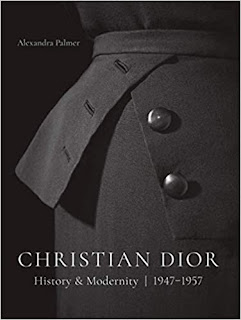Alexandra Palmer has authored a number of books about Christian Dior. This one is a peculiarly specific book: not a biography, nor a history of the Dior label, nor of Dior's collections and designs. Instead it is an in-depth look at the Dior garments held by the Royal Ontario Museum, and it delves into the design and construction of each piece of clothing, how its original owner acquired it, and how she adapted and wore it.
Palmer begins by exploring how Christian Dior's postwar designs were constructed, from the way they were cut to the final embellishments added to them. Can I just say, that after reading this I've put Dior's clothes into my "lovely to look at, but I definitely wouldn't want to wear them" category? Each garment was shaped and reinforced with facings, linings and canvas and horsehair padding. The wearer herself was frequently re-shaped by built-in, boned, corsets and "waist-cinchers". Lastly, some dresses (particularly the evening ones) had such complicated fastenings that the wearer needed help in getting dressed!
The garments held by the ROM were often altered by their original owners. At least one wearer reduced the number of bones in the bodice of her dress. Others added straps and modesty pieces to their dresses, shortened sleeves, and did more mundane alterations such as letting garments in or out, and raising and lowering hems. Dior was generally generous in his hem and seam allowances.
Here we come to the meat of the book. The second (and larger) part of Christian Dior: History & Modernity, 1947-1957 looks at each piece of Dior clothing in the museum in chronological order. Each chapter starts with the history of the model, continuing with some background on how the original owner acquired and wore it, how it was constructed, and how it differs from the model originally shown in Dior's collections. Each chapter contains photographs of the garment from the museum collection, and may also include pictures of the in-house sketches of the designs, fashion and press photographs of the original models, photographs of the clothes being worn by the original owner and technical sketches and patterns showing how it was constructed.
All in all, a book not only for those who enjoy exploring the technical details of fashion, but for those who want to know what happens to haute couture after it leaves the catwalks and makes its way into the wide world.
Alexandra Palmer
Christian Dior: History & Modernity, 1947-1957
Toronto: Royal Ontario Museum, 2018
ISBN: 9780888545213











